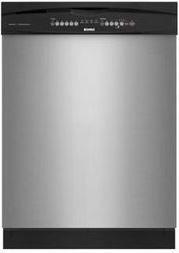 Kenmore Dishwasher Use and Care Guide
Kenmore Dishwasher Use and Care Guide
Kenmore Dishwasher Use and Care Guide
PRODUCT RECORD
In the space below, record the date of purchase, model, and serial number of your product. You will find the model and serial number printed on an identification label inside the dishwasher. Have this information available whenever you contact Sears about your product.
Model No. __________________________
Date of Purchase ____________________
Serial No. ___________________________
Save this information and your sales receipt for future reference!
PROTECTION AGREEMENTS
Master Protection Agreements
Congratulations on making a smart purchase. Your new Kenmore® product is designed and manufactured for years of dependable operation. But like all products, it may require preventive maintenance or repair from time to time. That’s when having a Master Protection Agreement can save your money and aggravation. The Master Protection Agreement also helps extend the life of your new product. Here’s what the Agreement includes: Parts and labor needed to help keep products operating properly under normal use, not just defects.
Our coverage goes well beyond the product warranty. No deductible, no functional failure excluded from coverage – real protection.
- Expert service by a force of more than 1 0,000 authorized Sears service technicians, which means someone you can trust will be working on your product.
- Unlimited service calls and nationwide service, as often as you want us, whenever you want us.
- “No-lemon” guarantee – replacement of your covered product if four or more product failures occur within twelve months.
- Product replacement if your covered product can’t be fixed.
- Annual Preventive Maintenance Check at your request – no extra charge.
- Fast help by phone – we call it Rapid Resolution. Phone support from a Sears representative on all products, Think of us as a “talking owner’s manual.”
- Power surge protection against electrical damage due to power fluctuations.
- $250 food loss protection annually for any food spoilage that is the result of mechanical failure of any covered refrigerator or freezer,
- Rental reimbursement if repair of your covered product takes longer than promised.
- 10% discount off the regular price of any non-covered repair service and related installed parts Once you purchase the Agreement, a simple phone call is all that it takes for you to schedule service. You can call anytime day or night or schedule a service appointment online.
The Master Protection Agreement is a risk-free purchase. If you cancel for any reason during the product warranty period, we will provide a full refund, or a prorated refund anytime after the product warranty period expires.
Purchase your Master Protection Agreement today!
Some limitations and exclusions apply.
For prices and additional information in the U.S.A. call 1-800-827-6655.
- Coverage in Canada varies on some items.
For full details call Sears Canada at 1-800-361-6665. Sears Installation Service
For Sears professional installation of home appliances, garage door openers, water heaters, and other major home items, in the U.S.A. or Canada call 1-800-4-MY-HOME®.
![]() SAFETY MESSAGES – Please READ & SAVE this information
SAFETY MESSAGES – Please READ & SAVE this information
We have provided many important safety messages in this manual and on your appliance. Always read and obey all safety messages.
![]()
![]()
![]()
![]()
![]()
![]()
- Misuse of the dishwasher can result in serious injury or death. Do not use the dishwasher in any way not covered in this manual or for any purpose other than those explained in the following pages.
- Severe product damage and/or injury could result from the use of unqualified service technicians or non-original replacement parts. All repairs must be performed by a qualified service technician using only original equipment factory replacement parts.
- Electrical shock or fire could result if the electrical supply for the dishwasher covered in this manual is incorrectly installed or if the dishwasher has been improperly grounded. Do not use the dishwasher covered in this manual unless you are certain the electrical supply has been correctly installed or the dishwasher has been properly grounded.
- Never use harsh chemicals to clean your dishwasher. Some chloride-containing products can damage your dishwasher and may present health hazards!
NOTICE
- It is highly recommended for the end user to become familiar with the procedure to shut off the incoming water supply and the procedure to shut off the incoming power supply. See the installation Instructions or contact your installer for more information.
- Never use steam cleaning products to clean your dishwasher. The manufacturer will not be liable for the possible damages or consequences.
WARNING: To reduce the risk of fire, electrical shock, or serious injury, observe the following:
- This dishwasher is provided with Installation Instructions and this Use and Care Manual. Read and understand all instructions before installing or using the dishwasher.
- This appliance must be grounded to a metal, permanent wiring system, or an equipment grounding conductor must be run with the circuit conductors and connected to the equipment grounding terminal or lead on the dishwasher. See the Installation Instructions included with this dishwasher for more information on electrical requirements.
- Use this dishwasher only for its intended function, which is the washing of household dishware and kitchenware.
- Use only detergents or rinsing agents recommended for use in a dishwasher, and keep them out of the reach of children.
- When loading items to be washed:a. Locate sharp items so that they are not likely to damage the door seal.b. Load knives and other sharp utensils with their HANDLES UP to reduce the risk of cut-type injuries.c. Do not wash plastic items unless they are marked “dishwasher safe” or the equivalent. For plastic items not so marked, check the manufacturer’s recommendations.d. Do not operate your dishwasher unless all enclosure Panels are in place.e. Do not tamper with or override controls and interlocks
- Do not abuse, sit on, or stand on the door or dish racks of the dishwasher.
- To reduce the risk of injury, do not allow children to play in or on the dishwasher.
- When children become old enough to operate the appliance, it is the legal responsibility of the parents or legal guardians to ensure that they are instructed in safe practices by qualified persons.
- Under certain conditions, hydrogen gas may be produced in a hot water system that has not been used for two weeks or more. Hydrogen gas is explosive. Before using a dishwasher that is connected to a hot water system that has been unused for two weeks or longer, turn on all hot water faucets and let the water flow from each for several minutes, open windows to ventilate the house. This will release any accumulated hydrogen gas. As the gas is explosive, do not smoke or use an open flame during this time.
- Remove the dishwasher door to the washing compartment when removing an old dishwasher from service or discarding.
- To avoid floor damage and possible mold growth, do not allow wet areas to remain around or under the dishwasher.
- Protect your dishwasher from the elements. Protect against freezing to avoid possible damage to the fill valve. Damage caused by freezing is not covered by the warranty.
DISHWASHER COMPONENTS
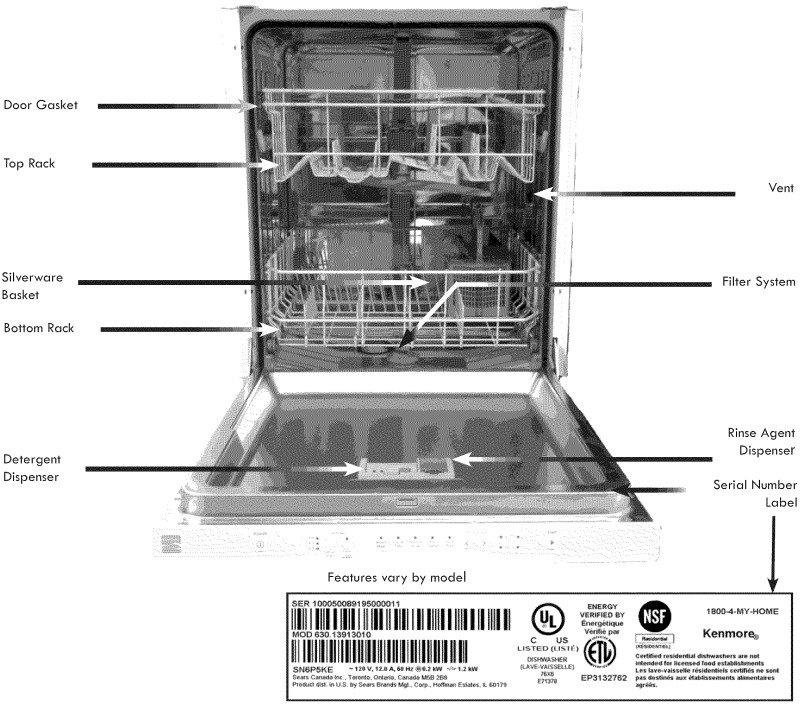



DISHWASHER FEATURES
QuietGuard™: A two-pump motor system, the Suspended Motor, and triple insulation make this dishwasher one of the quietest in North America.
Stainless Steel Giant Tub: A rust-free, hygienic interior surface.
Nylon Coated Racks: Greatly reduces cuts and nicks.
Concealed Heating Element: Heats water up to a sanitizing temperature.
EcoDry: A high temperature final rinse, a low temperature stainless steel tub, and the sheeting action of a rinse agent result in drying that is hygienic, energy efficient, and economical.
SmartSensor: Checks water condition and decides whether a second fresh water fill is necessary.
Triple Filtration System: Multiple filters ensure distribution of clean water and protect the main pump and the drain pump from foreign material.
Water Shut-Off: A safety feature that stops the flow of incoming water, if water is detected in the base of the dishwasher.
* Upper & Lower Rack Flip Tines: Increase the rack flexibility to accommodate larger/taller items.
* Dry Assist: Raises the temperature of the rinse water and increases the drying time which will result in improved drying.
* Adjustable Racks: The top rack can be raised or lowered to accommodate tall items in the top and bottom racks.
* SmartWash™ HE: Takes the guesswork out of cycle selection. The sensors in the dishwasher automatically adjust the cycle length, temperature and water changes based on the soil load.
* TurboClean™: Tackles hard-to-clean dishes in the lower rack, eliminating the need to soak and scrub heavily soiled dishes.
AquaGuard™: Leak protection system that cuts off the water supply in the event of a leak.
* model dependant
DISHWASHER MATERIALS
NOTE: Before using your dishwasher for the first time, check the information in this section. Some items are not dishwasher safe and should be handwashed; others require special loading.
RECOMMENDED
Aluminum: Colored anodized aluminum may fade over time. Minerals in your water may cause the aluminum to darken or spot. This can usually be removed with a soap-filled steel wool pad.
China, Crystal, Stoneware: Some hand-painted utensils may discolor, fade, or spot. Hand-wash these utensils. Position fragile glassware so that it will not topple over or come in contact with other utensils during the wash cycle.
Glass: Milk glass may discolor or become yellow.
Non-stick Coatings: Apply a light coating of vegetable oil to non-stick surfaces after drying.
Plastics: Make sure the plasticware is dishwasher safe.
Stainless Steel, Sterling Silver, and Silver Plates: Load these utensils in a way that they do not come in contact with other metals.
NOT RECOMMENDED
Acrylic: Crazing (small cracks throughout the acrylic) may occur.
Adhesive-Joined Pieces: Adhesives that join materials such as plastic, wood, bone, steel copper, tin, etc. may loosen.
Bone-Handled Utensils: Handles may separate.
Iron, Cast Iron: Iron will rust. Hand-wash and dry immediately.
Non-Dishware Items: Your dishwasher is intended for use in cleaning ONLY standard household dishware and kitchenware.
Pewter, Brass, Bronze: Pewter will tarnish. Hand-wash and dry immediately.
Tin: Tin will stain. Hand-wash and dry immediately.
Wood: Wooden bowls, wooden utensils, and utensils with wooden handles can crack, warp, and lose their finish.
Gold: Gold will discolor.
LOADING THE DISHWASHER
Do not pre-wash items that have loosely attached soiling. Remove large food particles, bones, seeds, toothpicks, and excessive grease. Items having burned-on, baked-on or starchy soils may require pre-treatment.
Refer to the Dishware Materials section for more information about dishware suitability.
- Load only dishwasher-safe items into the dishwasher.
- Load dishes in the dishwasher racks so that the insides of bowls, pots and pans are facing the spray arms.
- Avoid nesting and contact points between dishes.
- Separate items of dissimilar metals.
- Load dishes and glasses at an angle to avoid puddling and improve drying performance.
NOTICE
To avoid dishwasher damage, do not load the dishwasher with paper products, plastic bags, packing materials, or anything other than normal, dishwasher-safe dishware and kitchenware.
TOP RACK -SUGGESTED LOADING PATTERN


NOTE: Load cups and glasses between tines. Loading over the tines can cause breakage or water spots.
TOP RACK – ADDITIONAL LOADING PATTERN
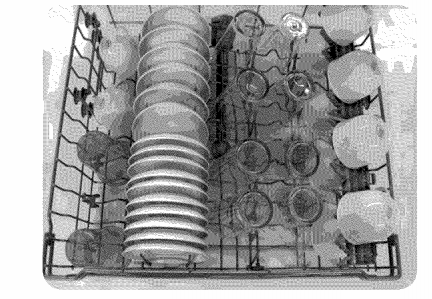

Loading the Top Rack
NOTE: Ensure items do not protrude through the bottom of the racks and block the spray arms.
NOTE: When pushing the top rack into the dishwasher, push it until it stops against the back of the tub so the top rack spray arm will connect to the water supply at the back of the tub. Do not push the top rack with the door.
Loading the Bottom Rack
Place large items in the bottom rack. Load pots, pans and bowls with the dirty surfaces facing the spray arms.
Unloading Sequence
- Unload the bottom rack first.
- Unload the silverware basket.
- Unload the top rack.
NOTE: Do not use rubber bands (to hold items in place in the racks) or any other after market parts in your dishwasher. The use of such items could potentially damage the drain pump.
BOTTOM RACK – SUGGESTED LOADING PATTERN
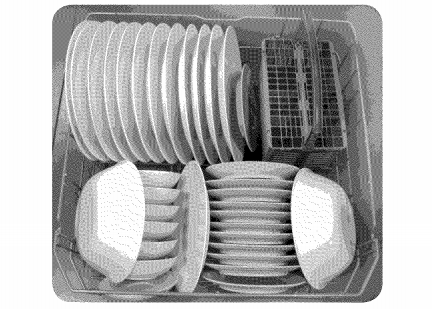

BOTTOM RACK – ADDITIONAL LOADING PATTERN
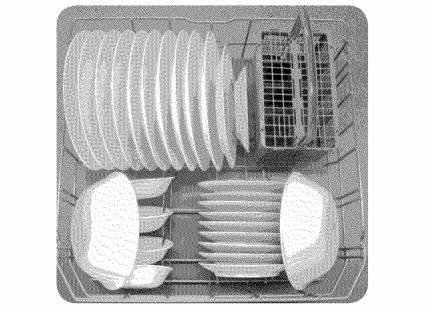

LOADING THE SILVERWARE
NOTE: The silverware basket tops can be folded up to accommodate large or oddly-shaped items.
With the silverware basket tops down, load the silverware basket following the patterns suggested below.
Place knives and sharp utensils with their handles up, and forks and spoons with their handles down. If large or oddly-shaped items are to be loaded into the silverware basket with the tops up, load the items so that they do not nest together.
Use suggested loading pattern for best results.
![]()
![]()
![]()
![]()
![]()
![]()
The sharp points and edges of knives and other sharp utensils can cause serious injuries. Load knives and other sharp utensils with edges down. Do not allow children to handle or play near knives and sharp utensils.
THE FLEXIBLE SILVERWARE BASKET
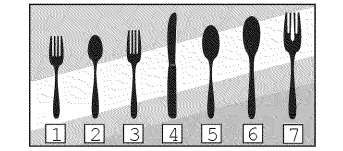

- Salad Fork
- Teaspoon
- Dinner Fork
- Knife
- Tablespoon
- Serving Spoon
- Serving Fork


The standard silverware basket fits in the back of the lower rack. The basket lid can be snapped to the handle to leave the basket open.


Basket Placement Option
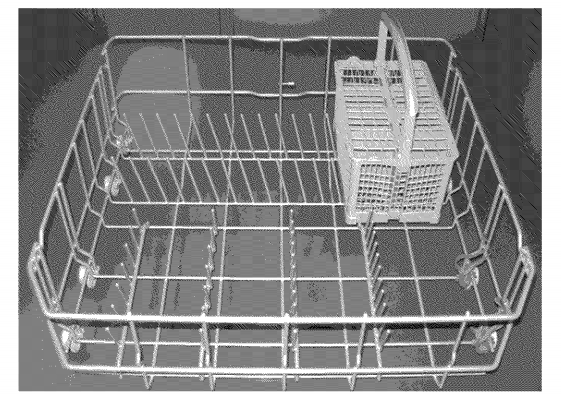

RACK FEATURES & ACCESSORIES
CUP SHELVES
Cup shelves are used to hold cups and other large items such as ladles and serving spoons. To use the cup shelves, fold them downwards so that they are positioned as shown below. Place cups and other items upside down on the shelves
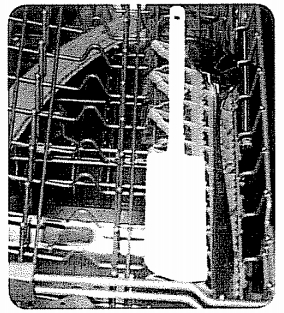

SMALL ITEM CLIPS
The small item clips keep lightweight items and plastic containers from tipping over and filling up with water during the wash cycle.
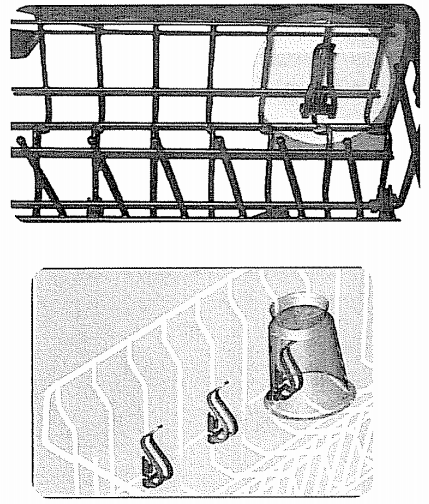

FLIP TINES
The racks on select models consist of tines that you can fold down or raise, depending on what you need to load in the rack.
To fold down:
- Grasp the tine near the locking mechanism.
- Release from notch.
- Push downwards.
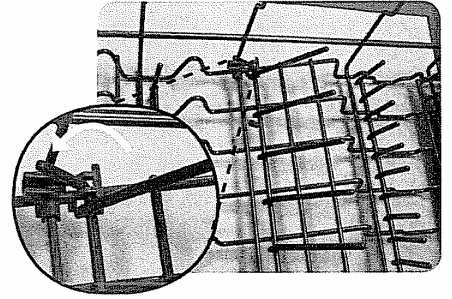

MANUAL RACK HEIGHT ADJUSTMENT
Remove the empty rack by pulling it out of the dishwasher to the point that it can be lifted upward, as shown above. Pull the rack outward and up until the rollers are completely free of the roller guides.


Re-insert the rack with the other set of rollers on the roller guides, as shown below.


DETERGENT
Detergent
Use only detergent specifically designed for dishwashers. For best results, use fresh powdered dishwashing detergent.
NOTICE
To avoid dishwasher damage, do not use hand dishwashing products in your dishwasher.
To avoid dishwasher damage, do not use too much detergent if your water is soft, it may cause etching in glassware.
The dishwasher uses less water so you need to use less detergent. With soft water, 1 tbsp. (15ml) of detergent will clean most loads. The detergent dispenser cup has lines that measure detergent to:
- 1 tablespoon (15ml)
- 1.75 tablespoons (25ml)
3 tablespoons (45ml) of detergent will completely fill the detergent dispenser cup.
NOTE: If you do not know the hardness of your water supply, use 1 Tbsp.(l 5ml) of detergent. Increase the amount, if necessary, to the least amount required to get your kitchenware clean.
Use the measuring lines in the detergent dispenser cup to measure the amount of detergent recommended in the Table.
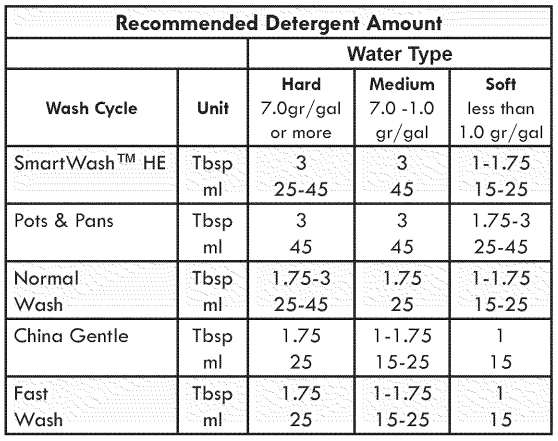

NOTE: When using gel packs, tablets or other dishwasher detergents, refer to the manufacturers instructions (normally 1 tab/dose).
Adding Detergent


- Use fresh powdered detergent for best results.
- 1 tablespoon will clean most loads.
- Do not use more than 3 tablespoons. Do not overfill.
- When using detergent tabs, lay them flat to avoid contact with the cover.
TO CLOSE
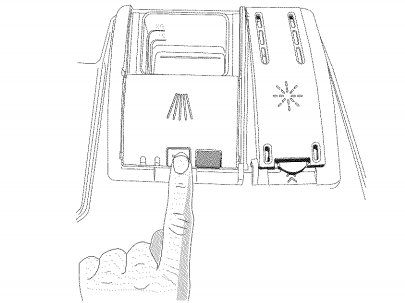

- Place finger as shown above
- Slide door forward and press down firmly until you hear a click.
TO OPEN
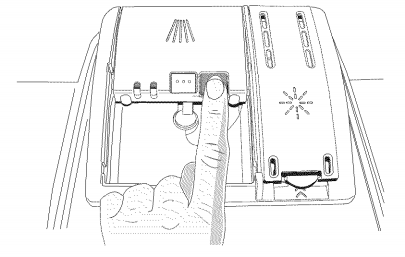

- To open the cover, push the button as shown above.
RINSE AGENT
Rinse Agent
To achieve proper drying, always use a liquid rinse agent, even if your detergent contains a rinse agent or drying additive.
NOTE: The Rinse Agent LED that illuminates when the Rinse Agent is low.
The LED will not illuminate if there is enough rinse agent in the dishwasher.
Filling the dispenser
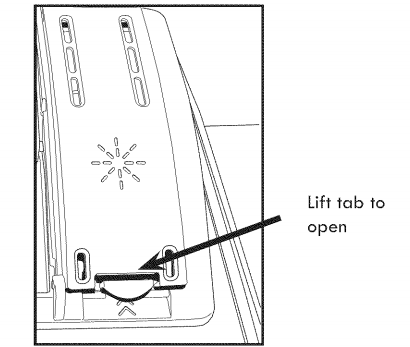

- Always use Rinse Agent even if your detergent contains rinse agent.
- Add rinse agent when the Rinse Agent Indicator Light on the control panel illuminates.
- Make sure the dishwasher door is completely open.
- Add liquid rinse agent to the dispenser as shown below until the rinse agent reservoir is full.
Wipe up any excess rinse agent that puddles when the dispenser reservoir is full to prevent oversudsing.
After filling the rinse agent dispenser, the indicator light will go out in a few minutes after the dishwasher door is shut (select models only).
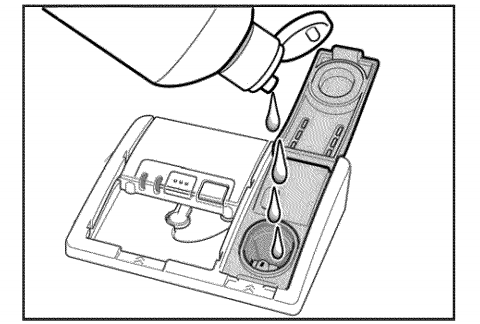

DISHWASHER CYCLES AND OPTIONS


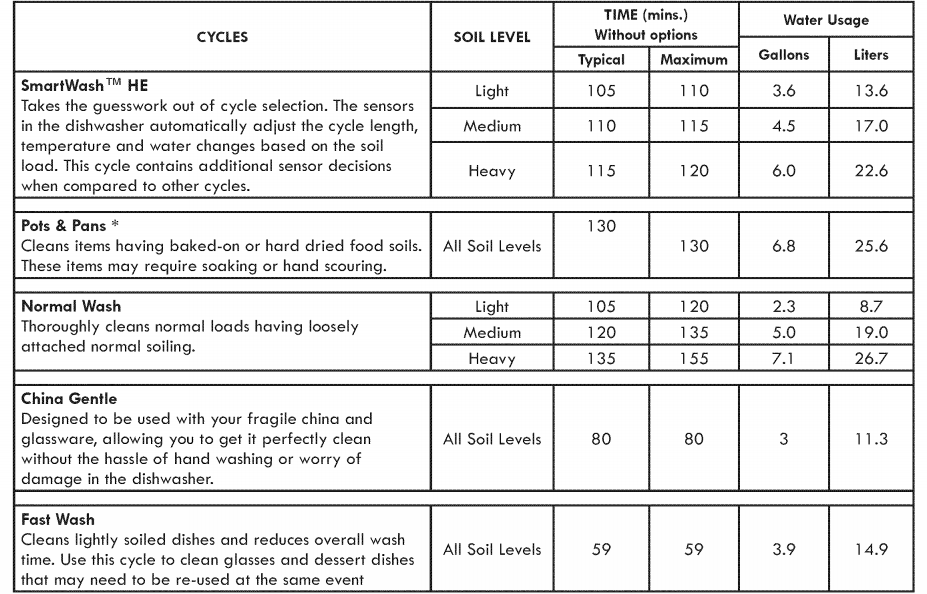

Adding options will increase or decrease the cycle time. See “Options” information section.
* The cycle is NSF certified.
NSF INFORMATION
A dishwasher or dishwasher cycle that is certified by the NSF international meets very strict requirements of wash time and water temperature to ensure dishware and kitchenware sanitization. These requirements are explained in the document NSF/ANSI 184, Residential Dishwashers. More information on NSF Certification is available at the NSF website, http://www.nsfconsumer.org/home/appliances.asp.
Your dishwasher is NSF certified. The dishwasher cycles that are NSF certified are shown in the chart above. When these cycles are complete, the “Sanitized” indicator on your dishwasher control panel will illuminate. However, if your household water supply is too hot your dishwasher’s heating time may be reduced, and the Sanitized indicator may not illuminate.
The cycle times listed in the Use and Care Manual are based on normal soil loads and 120°F incoming water and will vary based on your actual conditions.
NOTE: Only sanitizing cycles have been designed to meet the requirements of 6 for soil removal and sanitization efficacy. There is no intention, either directly or indirectly, that all cycles on a certified machine have passed the sanitization performance test.


Sanitized Indicator
When the “Sanitized” indicator light illuminates on the control panel, it means that the dishware and kitchenware that were just washed have been sanitized according to the requirements of the National Sanitation Foundation (NSF). For more information on NSF certification, refer to the tables in this section.
NOTE: The indicator light will come on for the cycles marked with an asterisk in the cycles and options tables.
OPERATING THE DISHWASHER


If your unit has a display window similar to the one shown above, follow the instructions below.
CANCELING A CYCLE
- Hold down the CANCEL button until the display shows “0:01”. Wait for the end of cycle indicator.
- Press “POWER” button to turn the unit off. Then press the “POWER” button again to turn the unit back on.
- One of the cycle LEDs will flash. This indicates that the unit has been reset.
CHANGING A CYCLE
If you need to change the running cycle to a new cycle:
- Hold down the CANCEL button until the display shows “0:01”
- Press POWER button to turn the unit off. Then press the “POWER” button again to turn the unit back on
- You can now select a new cycle.
Control Lock
- After pressing the “START” button you can activate the Control Lock feature.
- Press and hold down the “CHINA GENTLE” button until “CL” appears in the display window. Now any button you press (except POWER) will not function and “CL” will display each time.
- To deactivate, press and hold the “CHINA GENTLE” button until the “CL” disappears from the display window.
To enter the options mode:(rinse aid setting, dry assist)
- Door must be closed. Press the “POWER” button to turn the unit on.
- The countdown display and one of the Wash Cycle LEDs will be flashing.
- Press and hold the “NORMAL WASH” button, then press and release the “START” button. Now release the “NORMAL WASH” button.
- The display will show either “d:00 – d:01 ” or “r:00 – r:06”. You are now in the options setup mode.
- Press “NORMAL WASH” to select the option you would like to adjust.
If the display shows “d:00” or “d:01” you can turn the Dry Assist ON or OFF.
If the display shows between “r:00” to “r:06” you can adjust the amount of rinse agent dispensed.
To set the amount of Rinse Aid:
NOTE: If your glasses have spots on them, you need more rinse agent. If your glasses have streaks, you need less Rinse Agent.
Follow the instructions to enter “options” mode. With the display showing between “r:00” – “r:06“:
- Press the or “+” button to change the amount of rinse agent dispensed.r:00→Rinse Agent OFFr:03→Medium amount of rinse agent dispensedr:06→Highest amount of rinse agent
- Press “START” to save.
Dry Assist
With this option you can raise the temperature of the rinse water and increase the drying time for improved drying.
Follow the instructions to enter “options” mode. With the display showing “d:00” or “d:01”:
- Press the or “+” button to activate or deactivate dry assist.d:00→Dry Assist OFFd:01→Dry Assist ON
- Press “START” to save.
Delay Start
This option allows you to delay the start time of your cycle. To select this feature:
- First select the desired cycle.
- Then press the or “+” button until you see the desired delay time.
- The cycle will start once the displayed time elapses.
![]()
![]()
![]()
![]()
![]()
![]()
You could be seriously scalded if you allow hot water to splash out of the dishwasher. OPEN THE DOOR CAREFULLY during any wash or rinse cycle. Do not fully open the door until water noises have stopped.


If your unit has a display similar to the one shown above, follow the instructions below.
CANCELING A CYCLE
- Open the door.
- Hold down the CANCEL button until the “WASHING” LED goes out. Close the door.
- Wait for about 1 minute until the dishwasher drains.
- The “COMPLETE” LED will illuminate. This indicates that the unit has been reset.
CHANGING A CYCLE
If you need to change the running cycle to a new cycle:
- Open the door.
- Hold down the CANCEL button until the “WASHING” LED goes out.
- Wait for about 1 minute until the dishwasher drains.
- The “COMPLETE” LED will illuminate. This indicates that the unit has been reset.
- Press “POWER” button to turn the unit off. Then press the “POWER” button again to turn the unit back on.
- You can now select a new cycle.
To enter the options mode:(rinse aid setting, dry assist)
- Door must be open. Press the “POWER” button to turn the unit on.
- One of the wash cycle LEDs will be flashing.
- Press and hold the “>” button, then press and release the “START” button. Now release the “>” button.
- The “Sanitized” and one other LED will be flashing. You are now in the options setup mode.
- Press “>” to select the option you would like to adjust.
If the “COMPLETE” and “RINSE AID” LEDs are flashing, you are in the “Rinse Aid” mode. You can adjust the amount of Rinse Aid dispensed.
If the “COMPLETE” and “SANITIZED” LEDs are flashing, you are in the “Dry Assist” mode. You can now activate or deactivate Dry Assist.
If the “COMPLETE”, “SANITIZED”, and “RINSE AID” LEDs are flashing, you are in the “Cycle Completion Signal” mode. You can now increase or decrease the tone or deactivate the signal.
To set the amount of Rinse Aid:
NOTE: If your glasses have spots on them, you need more rinse agent. If your glasses have streaks, you need less Rinse Agent.
Follow the instructions to enter “options” mode. With the “COMPLETE” and “RINSE AID” LEDs flashing:
- Press the “<” button to change the amount of rinse agent dispensed.0 LEDs lit→rinse aid dispenser is OFF1 LED lit→Lowest amount of rinse aid dispensed2 LEDs lit→Medium amount of rinse aid dispensed3 LEDs lit→Highest amount of rinse aid dispensed
- Press “START” to save your settings.
Dry Assist
With this option you can raise the temperature of the rinse water and increase the drying time for improved drying.
Follow the instructions to enter “options” mode. With the “COMPLETE” and “SANITIZED” LEDs flashing:
- Press the “<” button to activate or deactivate dry assist.0 LEDs lit→extra dry heat is OFF1 LED lit→extra dry heat is ON
- Press “START” to save your settings.
Cycle Completion Signal (select models)
The cycle completion signal alerts you when a cycle completes and the dishwasher has washed and dried the dishes. You can choose to disable the tone or adjust the volume.
Follow the instructions to enter “options” mode. With the “COMPLETE” and “RINSE AID” LEDs flashing:
- Press the “<” button to adjust or deactivate the cycle completion signal.0 LEDs lit→cycle completion signal is OFF1 LED lit→Lowest tone level2 LEDs lit→Medium tone level3 LEDs lit→Highest tone level
- Press “START” to save your settings.
Time Delay
This option allows you to delay the start time of your cycle. To activate:
- Turn the dishwasher on.
- Select the desired wash cycle.
- Press the Delay Start button until the desired delay time illuminates in the “3Hr”, “6Hr”, “9Hr” LED.
- Press “START” to save your settings.
CARE AND MAINTENANCE
MAINTENANCE TASKS
Certain areas of your dishwasher require occasional maintenance. The maintenance tasks are easy to do and will ensure continued superior performance from your dishwasher:
- Wiping up Spills and Splash-outs
Water may occasionally splash out of your dishwasher, especially if you interrupt a cycle or open the dishwasher door during a cycle. To avoid floor damage and possible mold growth, do not allow wet areas to remain around or under the dishwasher.
- Clean the Stainless Steel Inner Door and Tub
Clean the outer edges of the inside door panel regularly to remove debris that might collect from normal loading. If spots begin to appear on the stainless steel tub or inner door, make sure the rinse agent reservoir is full.
- Clean the drain air gap
Clean the drain air gap periodically to ensure proper drainage of your dishwasher. With most types you lift off the chrome cover. Unscrew the plastic cap. Then check for any soil buildup. Clean if necessary.
- Check and clean the Spray arm nozzles
Occasionally check the spray arms to ensure that the spray arm nozzles (holes) are unobstructed. You must remove the spray arms to check them for obstruction.
To remove the top spray arm:


- Remove the empty top rack from the dishwasher.
- Turn the rack upside down. The top spray arm is held in position by a locking nut as shown above. Turn the locking nut counter-clockwise and remove it as shown above to release the spray arm.


- Remove the spray arm as shown above.
- Look for obstruction in the spray nozzles.
- If the spray nozzles need cleaning, flush them under running water.
To reinstall the top spray arm:
- Return the top spray arm to its installed position.
- Return the locking nut to its installed position and turn it 1/8 turn clockwise.
- Return the top rack to the top rack roller guides.
![]()
![]()
![]()
![]()
![]()
![]()
To avoid injury, do not reach into the large object trap with your fingers. The large object trap could contain sharp objects.
To remove the bottom spray arm:
- Remove the empty bottom rack from the dishwasher tub.
- Grasp and lift the bottom spray arm as shown below.

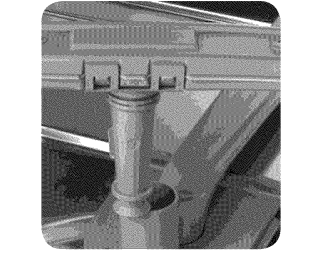
- Look for obstruction in the spray nozzles.
- If the spray nozzles need cleaning, flush them under running water.
To reinstall the bottom spray arm:
- Return the bottom spray arm to its installed position and press it so that it snaps into place.
- Return the bottom rack to its installed position.
- Check and clean the filter system
This dishwasher has a filter system that consists of a Large Object Trap/Cylinder Filter assembly and a Fine Filter. Select models have an additional Micro Filter.
The filter system is located on the inside of your dishwasher under the lower rack and is easily accessible. During normal use, the filter system is self-cleaning. You should occasionally inspect it for foreign objects and clean it when necessary.
To remove the Large Object Trap/ Cylinder Filter Assembly:
- Remove the bottom rack.
- Grasp the assembly and turn it counterclockwise– 1/4 turn as shown below.

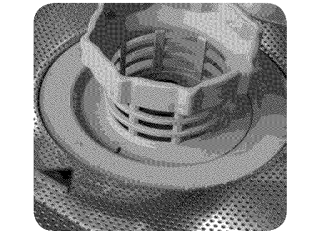
- Lift out the assembly as shown below.
- Carefully examine the assembly. If you find debris in the Large Object Trap, turn it upside-down and gently tap it on a surface such as a countertop to dislodge and remove the debris.

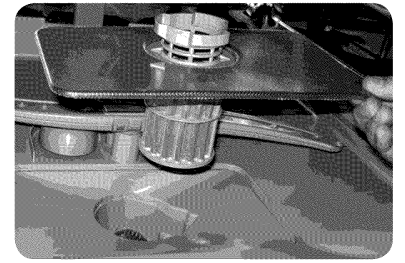
- Flush the Cylinder Filter clean by holding it under running water.
To reinstall the filter system:
- Return the fine filter to its originally installed position.
- Place the Large Object Trap/Cylinder Filter Assembly into its installed position in the dishwasher floor.
- Turn the ring handle clockwise 1/4 turn until it is locked.
- Gently pull the ring handle to ensure that the assembly is locked into place.

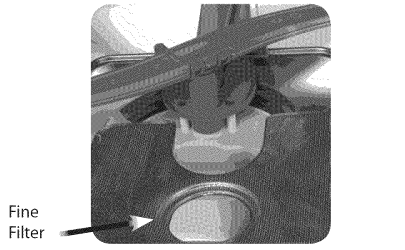
- Clean the Exterior Door Panel
Colored Doors
Use only a soft cloth that is lightly dampened with soapy water.
Stainless Steel Doors
Use a soft cloth with a non-abrasive cleaner (preferably a liquid spray) made for cleaning stainless steel. For the best results, apply the stainless steel cleaner to the cloth, then wipe the surface.
- Clean the Interior
Hard water minerals can cause a white film to build up on the inside surfaces, especially just beneath the door area. Do not clean the dishwasher interior until it has cooled. Wear rubber gloves. Do not use any type of cleanser other than dishwasher detergent because it may cause foaming or sudsing.
- Make a paste with powdered dishwasher detergent on a damp sponge and clean.OR
- Use liquid automatic dishwasher detergent and clean with a damp sponge
- Clean the Door Gasket
Regularly clean the door gasket with a damp cloth to remove food particles and other debris. Also clean the door seal, located inside the dishwasher at the bottom of the door.
- Winterizing Your Dishwasher
If your dishwasher will be unused for an extended period of time in a location that experiences freezing temperatures (e.g., in a holiday home or through a vacation period), have your dishwasher winterized by an authorized service center.
TROUBLESHOOTING
Dishwashers may occasionally exhibit problems that are unrelated to a malfunction of the dishwasher itself. The following information may help you with a dishwasher problem without involving a repair professional. The Items listed in the following charts may not be covered by your product warranty.
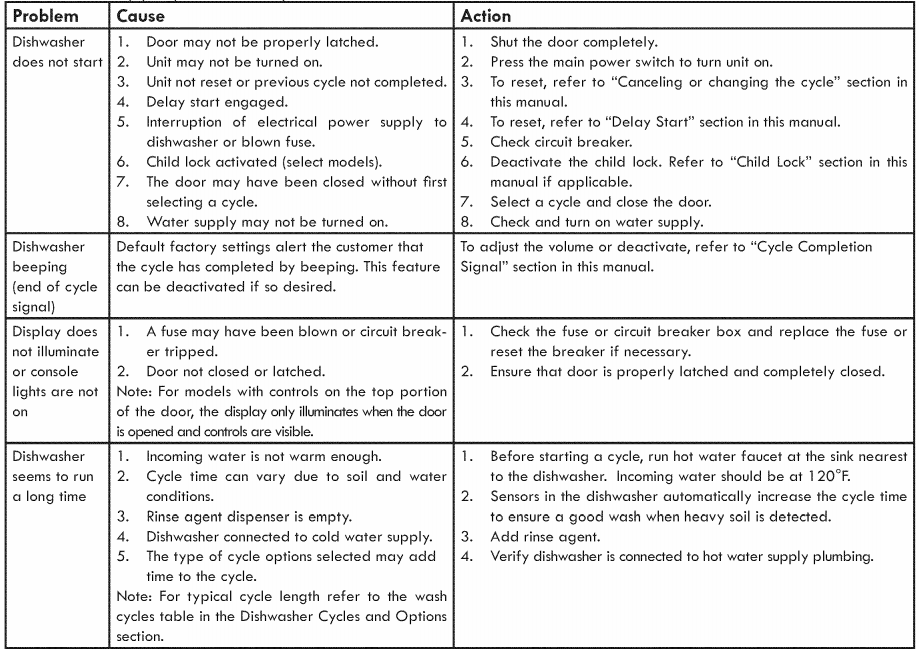

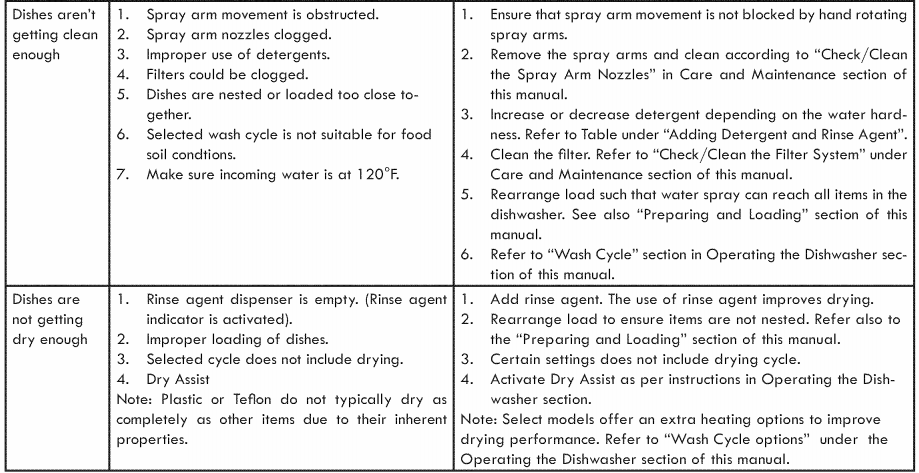

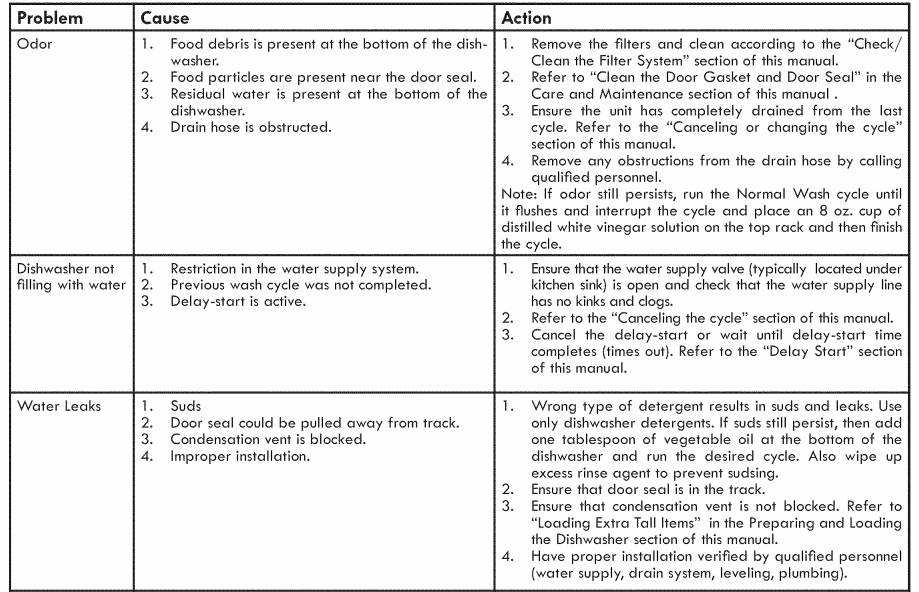

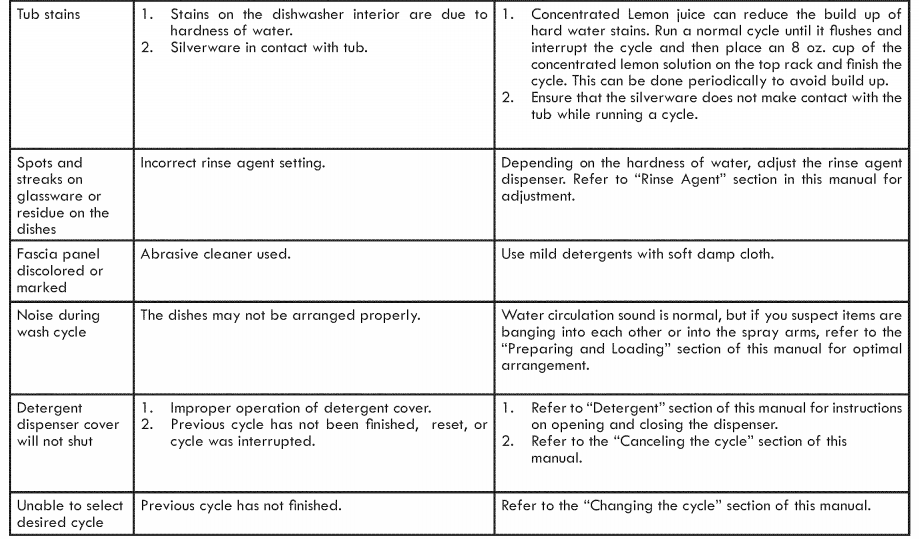

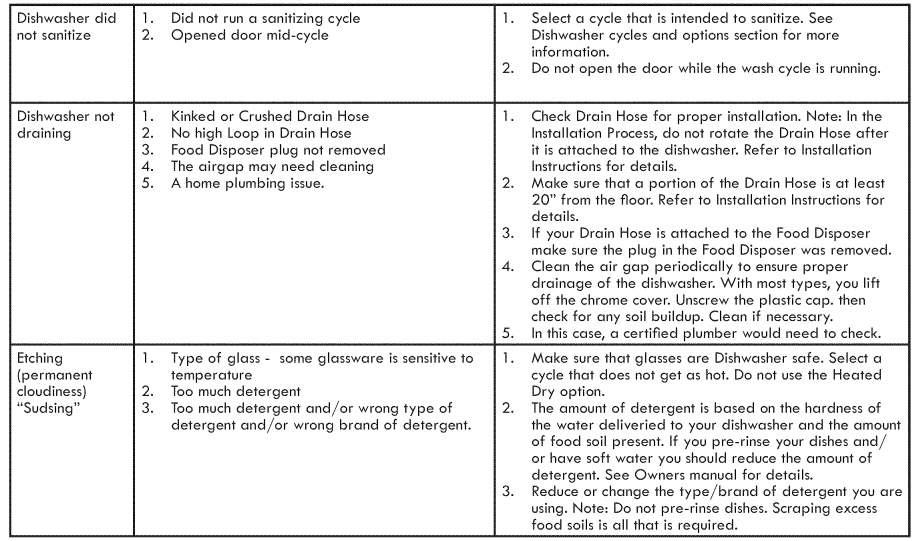

FAQS
What is NOT covered under my agreement?
The Master Protection Agreement is not insurance and does not cover loss due to fire, theft or vandalism; loss from acts of God; loss from normal wear and tear; cosmetic damage; damage caused by accidents or negligence; pre-existing conditions; failure to follow installation instructions; commercial use; rental use; operation outside the United States/Canada;
How do you self clean a Kenmore dishwasher?
Press on the heated dry button, then press the standard wash button, then the heated dry button again. Finally, press the standard wash button again. Once you press those four buttons in a row, your Kenmore dishwasher will start a 12-minute test cycle.
Do all dishwashers have filters?
And yes, your dishwasher does have a filter, which means it needs routine maintenance checks, much like a filter in your car or the home furnace. The dishwasher filter plays a huge role in keeping your dishwasher running efficiently for years to come; thus, regular cleaning is a must.
Is vinegar bad for dishwasher?
While vinegar may not destroy your dishwasher, it’s not an effective alternative to dishwasher cleaners. The acidic liquid might also react with some parts of the appliance and can, over time, cause rubber gaskets and hoses to deteriorate.
Is dishwasher cleaner necessary?
Even though your dishwasher’s job is to clean, it too needs a once-over periodically. Over time, food residues gunk up the drain and spray arms. The clogs reduce the amount of water circulating during the wash and rinse cycles and dishes can end up with a film of baked-on food and soap.
Can you put baking soda and vinegar in dishwasher?
Run a short hot water rinse cycle (skip the drying cycle), and then open the dishwasher door to allow the interior to air dry. The vinegar will strip away any grease buildup, and the baking soda will remove lingering odors.
Does vinegar damage rubber seals?
Vinegar is sometimes used as a fabric softener or for getting rid of stains and odors in laundry. But as with dishwashers, it can damage the rubber seals and hoses in some washing machines to the point of causing leaks.
Should you run vinegar through your dishwasher clean it?
Fill a dishwasher-safe bowl with 1 cup of white vinegar and place it on the bottom of the empty dishwasher. Set the dishwasher to run on a hot water cycle. The vinegar will break down any remaining bits of food, grease, soap scum, residue, and any other leftover grime.
How often should you use dishwasher cleaner?
Clean your dishwasher monthly to prevent a buildup of germs and maintain the efficiency of the machine — you want to make sure your dishes are clean!
What is the lifespan of a dishwasher?
About 10 years, according to most of the 20-plus manufacturers we asked. CR members tell us they expect the same life span, on average, but that doesn’t necessarily mean 10 trouble-free years.
Is there a cleaner for dishwashers?
Recommended by several top dishwasher brands, Affresh tablets work in all types of dishwashers. An Affresh tablet once a month in your dishwasher may also mean the difference between spending money on a new dishwasher and being able to maintain your current appliance.
What is better for dishwasher liquid or powder?
If you’re looking for the most sustainable and eco-friendly option, powdered dishwasher detergent is the choice for you. Dishwasher powder is seen as the most effective against hard water (or water that leaves spots due to high mineral content) and is relatively inexpensive
How often should you put dishwasher salt?
Each wash will use up some salt to soften the water. So, depending on your usage you should make it a habit to top up the dishwasher with salt at least once a month. It is impossible to put too much dishwasher salt and cause cutlery corrosion.
Will vinegar damage your dishwasher?
While vinegar may not destroy your dishwasher, it’s not an effective alternative to dishwasher cleaners. The acidic liquid might also react with some parts of the appliance and can, over time, cause rubber gaskets and hoses to deteriorate.
Is dishwasher cleaner necessary?
Even though your dishwasher’s job is to clean, it too needs a once-over periodically. Over time, food residues gunk up the drain and spray arms. The clogs reduce the amount of water circulating during the wash and rinse cycles and dishes can end up with a film of baked-on food and soap.
What happens when you mix dawn and vinegar?
“Vinegar is a good cleaner because it’s acidic, but when you add dishwashing liquid/dish soap to it (which is a base or neutral) – you neutralise the vinegar. You take away the very thing that makes it work well. “The dishwashing liquid works that well on its own.
Kenmore Dishwasher Use and Care Guide – Kenmore Dishwasher Use and Care Guide –
![]()
![]()
[xyz-ips snippet=”download-snippet”]


